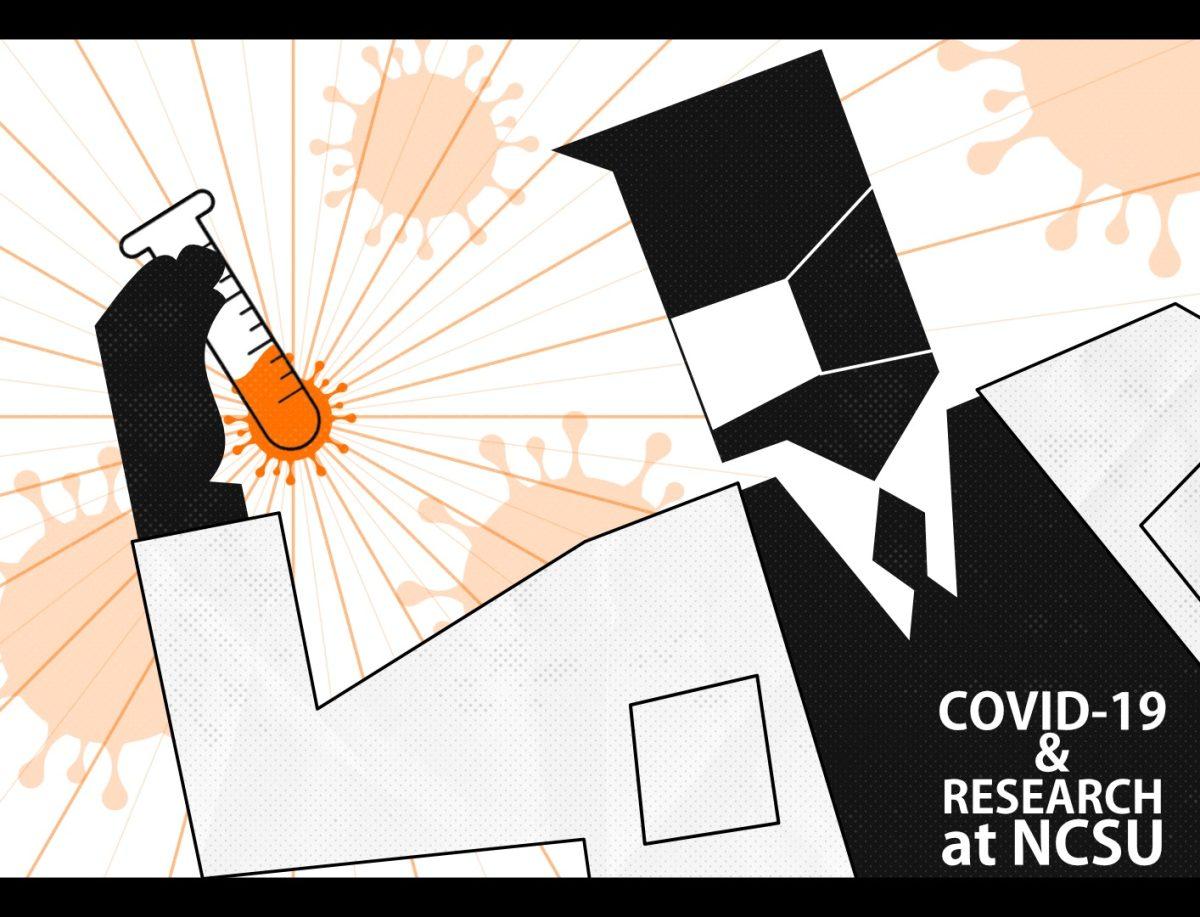
COVID-19 research and innovation graphic
From last spring to the current semester, NC State professors and graduate and undergraduate student researchers have been applying their skills and knowledge to further our understanding of COVID-19.
Robert Handfield, the Bank of America University Distinguished Professor of Supply Chain Management in Poole College of Management, has utilized his work on the digital transformation of supply chains and the procurement of buyer-seller relationships, particularly in the pharmaceutical sector.
“When COVID struck, I was asked by a colleague…to serve as a pro bono expert to the joint acquisition task force,” Handfield said. “This was set up to help the nation try to identify sources of PPE, [or] personal protective equipment, N-95 masks, gowns, gloves, etc.”
Handfield said this research involved conversations with the Federal Emergency Management Agency, the U.S. Strategic National Stockpile, the Department of Homeland Security and hospital staff and administrators. According to Handfield, his results indicate the need for a national testing strategy.
“I was also asked to be involved in a study funded by [the National Institute of Standards and Technology] through the CARES Act,” Handfield said. “[This study] was focused on developing a testing strategy for the nation, so helping to understand how to distribute tests, the PCR COVID test, as well as the antigen and antibody test.”
Handfield said he has been involved with advising North Carolina on vaccine distribution efforts alongside Julie Swann, the department head of the Fitts Department of Industrial and Systems Engineering.
“I’ve been working on pandemic modeling since 2007,” Swann said. “I, with a team of researchers at my previous institution, built an influenza pandemic model that we use to look at distribution decisions over a geographical network. I was on loan to the Centers for Disease Control and Prevention (CDC) in 2009 and 2010 for the H1N1 pandemic response, where I looked at logistics and supply chains, including state systems for delivering vaccines.”
According to Swann, the influenza pandemic model has been transitioned to apply to COVID-19 after her team received a grant from the CDC and the Council of State and Territorial Epidemiologists, with additional funding from NC TraCS Institute at Chapel Hill and NC State. Swann’s team is made up of researchers from NC State, UNC-Chapel Hill and Georgia Tech.
“With these disease models, we look at all kinds of different things, including the impact of wide scale adoption of masks and face coverings, the impact of vaccine distribution, including not only in aggregate, but also for subpopulations,” Swann said. “We looked at equity across the network, distribution of vaccines and outcomes in communities of color, as well as across urban and rural geographies.”
Yang Cheng, an assistant professor of communication, has been researching crisis communication, public relations and the impact of new technology for the past five years, before a recent pivot to COVID-19.
“My recent article is based on our national online survey of nearly 2,000 adults in April during the COVID-19 pandemic, to examine the age disparities in preventive behaviors against the virus,” Cheng said. “The results show that older generations, motivated by a higher perceived severity of the disease, were more likely to take the precautionary actions recommended by the CDC than younger generations.”
Cheng has also published research on COVID-19 misinformation in the Online Information Review, which she said is a pertinent issue surrounding the pandemic.
“We find that, in the U.S., people are very optimistic about their own ability to evaluate or identify misinformation by themselves,” Cheng said. “They always think that misinformation has a bigger impact on others than themselves during the pandemic on social media platforms… We find that this kind of effect would make it harder to get people to participate in media literacy, education and training efforts because most people think like that others need the training more than they do.”
Deyu Xie, professor of plant and microbial biology, published findings in Frontiers in Plant Science that suggest compounds found in green tea and muscadine grapes can inhibit the function of a protease in SARS-CoV-2.
“I am studying how plants make proanthocyanidins, how we can engineer them and then understanding their nutritional value from a human health perspective,” Xie said. “It was natural for me to move in this direction. Since I work in agriculture, it’s hard for me to really test the nutritional value in a medical application at this time… What I learned is that many natural chemical products have very strong antiviral activity, basically.”
Xie said his confidence in his knowledge on plant flavan-3-ols and proanthocyanidins, two types of plant metabolites, encouraged him to apply this chemical library to COVID-19 in a meaningful way.
“When America announced the lockdown, I worked with my students and said ‘If possible, let’s just work out a project to see whether or not we can find anything which may be useful, or may be preventive or whatever functions [the compounds] have to prevent or treat this virus,’” Xie said.